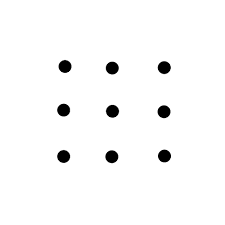WHAT BOX?
I am sure that you are familiar with J. P. Guilford’s famous study, the nine-dot puzzle. The challenge is to connect all nine dots using just four straight lines without lifting your pencil from the page.

You may know from your own experience that during the first attempts you feel compelled to keep your lines within an imaginary square, which you unconsciously project around the image of the nine dots.
The usual solution, however, requires you to draw lines that extend beyond the area occupied by the dots.
The typical accepted solution, however, requires you to draw lines that extend beyond the area defined by the dots.
This challenge was to demonstrate how participants censor their own thinking by limiting the possible solutions to those within the imaginary square. And this experiment may very well be the origin of a new method: “Thinking Outside the Box”.
The phrase itself has become a mantra especially in the business world when it comes to finding innovative solutions to new, complex challenges.
ALWAYS FROM SCRATCH?
At its core, innovation is about solving difficult problems.
Right, but does innovation require totally new, unique thoughts, ideas, processes?
We tend to think that: yes, most of us have a concept like that in our mind.
Let us have a quick glance at some of the established images related to innovations.
- The individual eccentric genius inventor.
- The laboratory research team which requires highly experienced team members and well funded support.
- And … the manager expected to think outside the box.
At this point other questions arise:
What is there to be found beyond such clichés?
How do innovations and creative problem-solving work in practice?
What processes do innovators follow? Are there patterns to be recognized?
These questions must have come to the great inventor, innovator and researcher, Genrikh Saulovich Altshuller (Ге́нрих Сау́лович Альтшу́ллер) at the end of the 1940s when in the navy he faced an unusual challenge: how to help others to innovate.
“Sailors can draw maps of reefs and shallow waters that others can follow, but inventors have no such maps. Each beginner goes along making the same mistakes.”
When charged with scaling the navy’s creativity without a structured methodology, Altshuller committed himself to making one.
TRIZ40 – A SYSTEMATIC WAY
Studying thousands of patents he exposed the scarcity of genuinely revolutionary thinking and detected a logic for systematic innovation, later to be known as TRIZ (a Russian acronym for the ‘Theory of Inventive Problem Solving”). Through TRIZ, Altshuller was able to demonstrate the science behind creative innovation.
Here are the three primary findings of TRIZ, formulated by the author:
1. It’s been solved before.
2. There are consistent patterns of solutions.
3. Solving contradictions creates breakthrough innovation.
TRIZ works to formalize the belief that somebody, somewhere has already solved your problem. TRIZ helps us recognize engineering strategies that have converged across categories and industries, when faced with shared technical constraints. In TRIZ the patterns of solutions are classified based on their related technical features. These are known as inventive principles. In total, the TRIZ methodology recognizes that there are 40 inventive principles that can be used to inspire innovation.
TRIZ’s inventive principles include concepts such as segmentation (principle 1): describing solutions that break up an object into its independent parts (like modular furniture or Venetian blinds). Do it in reverse (principle 13) is another favorite, in which the movable part of an object or environment is held stationary, and the stationary part made moveable (like a swimming training pool where the water moves, not the swimmer). The inventive principle nested doll (principle 7) classifies patterns of solutions that place one object inside another (like the typical Russian doll), helping to represent an array of adaptations from several technical categories. A nail polish brush that’s screwed inside its own bottle is an example of a nested doll.
To create breakthrough inventions, one must overcome a contradiction (or trade-off). TRIZ helps to address challenges like “How might we make a bulletproof jacket stronger without it becoming heavier?” or “How might we make an umbrella big enough to cover a human body but not so large it doesn’t fit in a handbag?”
Altshuller concluded that there were about 1,500 standard engineering contradictions which he then summarized into a contradiction matrix comprising 39 parameters. These parameters include physical constraints (like weight and shape), performance parameters (think speed, power, and stability), and efficiency limitations (like time, temperature, and information). For each contradiction identified in the matrix, TRIZ then maps the most relevant inventive principles for a solution.
We can say with the words of Altshuller: “There is no magic formula after all, but there are procedures that are sufficient in most cases.”
MY POSITION
I personally find it amazing how http://www.triz40.com/TRIZ_GB.php works, just visit the website and play with the options.
Frankly speaking, as an engineer and manager I had never heard of the TRIZ40, for me it came as a revelation that somebody had developed such a system of systematized knowledge about creative thinking and innovation.
What do YOU think about the methods of innovation?

Leave a Reply